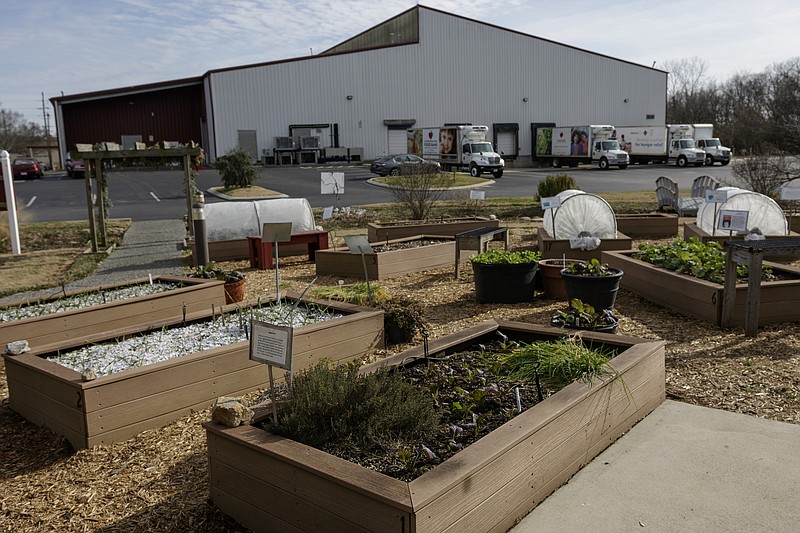Get Involved
For more information, contact Jennifer Lockwood at 423-622-1800 or jlockwood@chattfoodbank.org.
First, the good news.
Thanks to President Donald Trump, Christmas is coming early to the Chattanooga Area Food Bank.
Early and often and a lot.
In September, the White House, trying to offset damage done to U.S. farmers through our growing trade dispute with China, created a $1.2 billion buyout plan to purchase food from our nation's farms.
Whole chickens. Fruits. Vegetables. Pork and beef. Milk.
Over the next year or so, as part of this farmer-aid bailout, the U.S. Dept. of Agriculture will more than double the food it distributes to some of our nation's most trusted food banks - including our own Chattanooga Area Food Bank - in order to reduce hunger in America.
Earlier this week, the first shipment arrived.
"A truckload of grapes," said Jennifer Lockwood, the food bank's executive assistant. "The entire shipment has been distributed."
This year, the food bank distributed some 15.1 million pounds of food - fruit, vegetables, shelf-stable items - to nearly 137,000 local men, women and children fighting hunger.
Fifteen million pounds? That's the equivalent of some 12.5 million meals.
Now, thanks to the White House, the food bank will receive as much as six million more pounds of food over the next 12 months.
That's a possible increase of 40 percent.
It's like waking up and finding Santa doubled the amount of presents under the tree. (Did I just compare Trump to Santa?)
This brings us to the challenging news.
Where do you put all these new presents and gifts?
The food bank's Amnicola Highway storage facility is 44,000 square feet of pallets, boxes, freezers and fridges of food - fresh bananas, Little Debbies, juice boxes, canned soups - stacked like Home Depot and distributed like Amazon through hundreds of partner agencies - church pantries, Salvation Army, Metropolitan Ministries - across 20 counties in East Tennessee and North Georgia.
All of it - every ounce, every olive - is tracked.
So where do you store an extra six million pounds of food when your storage facility is already full?
How do you distribute it?
How do you pay for the extra freezers? Truck fuel?
"That's the top challenge," said Mark Hilling, the food bank's chief operating officer.
The Chattanooga Area Food Bank, already operating on a $27 million budget, could spend an extra $600,00 on receiving, storing and distributing this food. Yes, it's free, but the delivery trucks, gasoline, storage space, freezers and extra staff aren't.
That means our area's food bank needs our help.
Here's the food bank's Christmas wish list:
* 50 pallets of freezer space
* 50 pallets of refrigerator space
* 100 pallets of dry space, 50 pallets of freezer space, 50 pallets of refrigerated space in Dalton, Georgia. (The food bank has a distribution facility there, too.)
* Two trucks and drivers, three warehouse workers and any increased funding to pay an extra 38,000 miles and 4,100 additional gallons of fuel.
Gina Crumbliss, the food bank's president and CEO, says that in our 20-county range, folks went hungry nearly 10 million times in 2018. They call it "missing meals." The time when the seventh-grader went to school without breakfast. Or the grandmother spent grocery money on medicine. Or the veteran ate one meal a day instead of three.
Most food bank clients work and have attended college.
The average client looks more like, well, you rather than a homeless man under the bridge. (Yes, they receive food, too.)
Thankfully, this influx of USDA food allows the food bank to expand its work, reaching farther into the crisis of regional hunger.
"This will propel us forward in our mission to end hunger in our region by 2025," Crumbliss said.
Since 2015, the food bank has distributed some 50.3 million meals, or 12.6 million meals per year.
View other columns by David Cook
Its vision? Regional hunger ends when 21 million meals are distributed each year.
Trump's food plan will catapult the food bank closer to reaching that goal. Even though Washington's extra-food ends after one year, it will stretch the food bank into bigger capacity; successfully handling the USDA influx will allow the food bank's increased distribution levels in 2019 to become the new normal.
Which means more food is distributed.
And fewer people go hungry.
"We do see this as propelling us where we need to be," Crumbliss said.
If that isn't a Christmas wish, then I don't know what is.
David Cook writes a Sunday column and can be reached at dcook@timesfreepress.com or 423-757-6329.

